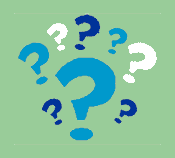
As a wrap-up to a lecture or class discussion, try a question-only session. The original idea came from a conference of Lincoln Center Teaching Artists in New York City. These folks are the real deal in teaching; I was blown away by the intensity of the sessions and teaching tools (not to mention the self-knowledge) I carried away from each day's activities.
How to:
Everyone in the class jots down a question on a scrap piece of paper. The questions can take any form (who, what, where, etc), and should be based on the class lecture or discussion. When everyone has written a question down, call for all the questions by going around the room, but DO NOT ANSWER them. Everyone participates (even if they just say "pass). You'll be surprised at what you'll learn about not only your students but about your field of study! And your students will be really surprised at how inquisitive they actually are.
Here are some things to keep in mind.
o Give an example (or two!) of the type of question you mean. Questions should be related to the class lecture or discussion.
o Questions can be something that students are still wondering about, or can be very general questions about the topic under discussion.
o If students are struggling to come up with a question, have them write down one fact that they learned in class that day, and turn that into a question. For example, after a lecture on traditional literature, students may have learned that the "trickster character" in many African countries is named Anansi the Spider. A question that might be developed off that fact is: "How did the spider come to be used as "the trickster" in Africa, but in western culture, it's often a fox?" Or "Who was the first person to tell an Anansi story?" Or "Are there other trickster types besides Anansi in traditional African tales?"
o Students are allowed to say "pass" if they don't want to participate. This also makes it easy for students who don't "get it" the first time you do this.
o DO NOT ANSWER the questions, even if you know the answer! Just let the questions fly! Let the spirit of "lifelong learning" seize the class.
o The first time you do this, be sure to give students at least 3-4 minutes to come up with a question. You may even suggest that they come up with 3-that puts the pressure on, and they're almost sure to come up with at least one question.
o It takes about 8-10 minutes to run the whole "show," from the introduction of the idea, to the writing, to the speaking.
o Encourage students NOT TO PACK UP THEIR THINGS until everyone has spoken their question.
o If a question is really outstanding, at the end of the session, ask the student to give you a copy, or jot it down yourself and answer it at the beginning of the next class. This is a GREAT transition, and also shows the value of the question-only session as a tool for further inquiry.
VARIATIONS:
The pre-emptive strike question-only session
As the name suggests, have students ask questions about a text under discussion before you start the class lecture or discussion.
"Upcoming-assignment" question-only session:
Have a big project or paper coming up? Take the last 10-15 minutes of class and have students brainstorm with a partner, discussing approaches to the project, etc. Each person has to write down 3 questions that the other person asked them. Then, you open up the floor for questions only. That's a really fun one. You'll learn very quickly what they're apprehensive about.
"I didn't know":
This is actually an idea I got from an 8th-grade middle school English teacher. Apparently, one day her students were pestering her with so many questions (for which she had no answers) that finally she yelled out in frustration: "You know, I can't know everything!" She asked all her students to take out a piece of paper and write down 10 things that they just "don't know." She said the results were amazing! The students were all humbled by one another's admissions. I re-conceived the idea for my college-level students who really seem to know just about everything (ahem). So here's how it goes.
Students write an "I didn't know" statement about something that they learned in class that day.
Here are some things to keep in mind...
o I ALWAYS go first AND LAST with this one.I say something that I didn't know before coming to class that day, or something that I learned that was new when I was reviewing my lecture notes. THEN. I try to pay really close attention to the students, and try to learn on the spot from what they're saying, and try to conclude with a brand-new thing that I learned at just that moment. For example, it could even be "I didn't know that Anansi the Spider was so fascinating to y'all!" if many students said that they didn't know about Anansi before coming to class.
o I use the "I didn't know." session only after I've done the question-only session a few times in previous classes. They're a lot more comfortable speaking out about something they didn't know if they know the routine from the question-only session.
o The fun thing about this is I used to think that students already knew everything I was saying before I said it. WRONG! It was very gratifying to hear that even some of the simplest things were new to them.
o It's also nice for them to hear that their peers all learned something, too-that they weren't the only one in the class who "didn't know" a fact.
No comments:
Post a Comment